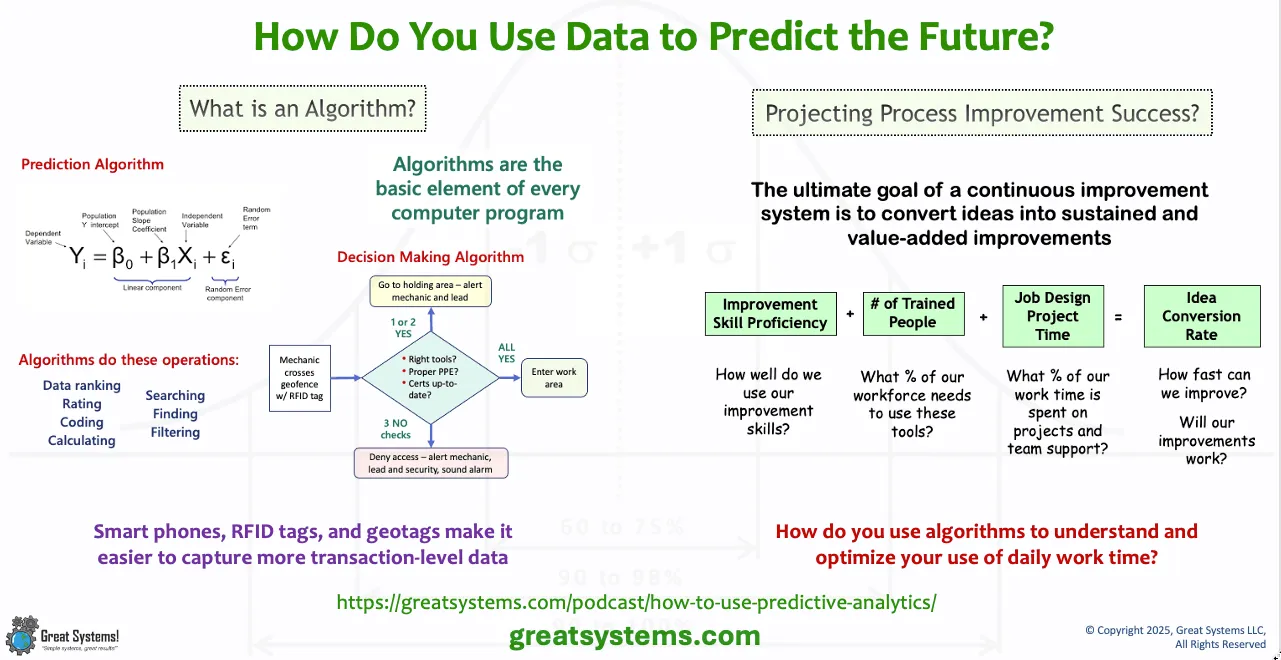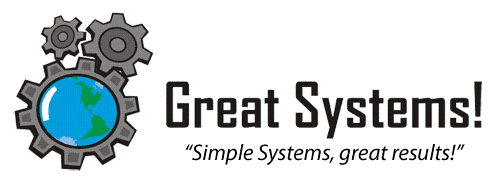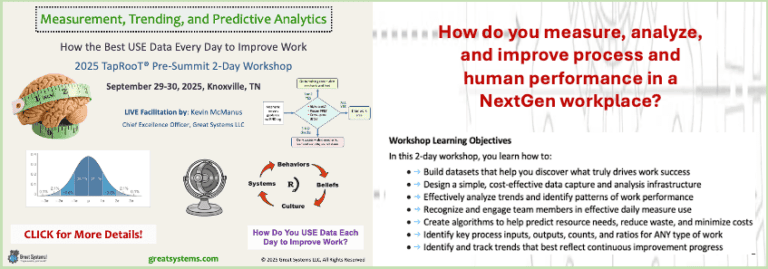How to Use Predictive Analytics at Work

How to Use Predictive Analytics to Improve Work
Capture – analyze – use. Predict, prepare, and choose. This week’s Real Life Work podcast looks at how to use predictive analytics at work to help predict process outcomes and optimize results.
Plus, this content comes from the second day of my new ‘Measurement, Trending, and Predictive Analytics’ 2-day workshop. My goal is to provide an ‘easy-to-understand and use’ overview of what can be a complex topic. This is fresh material that will help you use predictive analytics more effectively at work.
For starters, what are predictive analytics? How do people use measures to predict the future? How might you benefit from the use of simple algorithms and data capture tech that exist?
Conversely, if you do not want to think about work for the next 30 or so minutes, use this content to help you pick a stronger fantasy baseball team. Predictive analytics might even help you understand why your bracket went bust in the early rounds of the women’s or men’s NCAA basketball tournaments.
At any rate, code and formulas make the digital world go around. Code rules.
Plus, this content comes from the second day of my new ‘Measurement, Trending, and Predictive Analytics’ 2-day workshop. My goal is to provide an ‘easy-to-understand and use’ overview of what can be a complex topic. This is fresh material that will help you use predictive analytics more effectively at work.
For starters, what are predictive analytics? How do people use measures to predict the future? How might you benefit from the use of simple algorithms and data capture tech that exist?
Conversely, if you do not want to think about work for the next 30 or so minutes, use this content to help you pick a stronger fantasy baseball team. Predictive analytics might even help you understand why your bracket went bust in the early rounds of the women’s or men’s NCAA basketball tournaments.
At any rate, code and formulas make the digital world go around. Code rules.
What are Predictive Analytics?
The use of predictive analytics to improve performance is not a new thing. It is more of a new phrase for proven post-World War Two practices. For example, Statistical Process Control (SPC), along with correlation and regression analysis, have been foundational statistics tools for decades.
Back in the 1980s, I made use of regression analysis to help predict and reduce monthly plant electrical costs. Similarly, this same site made consistent use of production capacity models and forecasts.
Thankfully, personal computers and spreadsheets had just begun their entry into the workplace. Today, algorithms provide such assistance with a click.
By definition, algorithms are the basic element in any program. We all rely on formulas, such as if / then / else statements, to access our online accounts and use automated teller and checkout services. When it comes to our operational excellence future, code is poetry.
In general, the goal of predictive analytics is to develop models that accurately predict an outcome (y) based on one or more variables (x). Plus, such data serve as inputs into algorithmic management tools that are replacing humans for routine cognitive work.
However, the potential does exist for these tools to become futuristic micromanagers.
Back in the 1980s, I made use of regression analysis to help predict and reduce monthly plant electrical costs. Similarly, this same site made consistent use of production capacity models and forecasts.
Thankfully, personal computers and spreadsheets had just begun their entry into the workplace. Today, algorithms provide such assistance with a click.
By definition, algorithms are the basic element in any program. We all rely on formulas, such as if / then / else statements, to access our online accounts and use automated teller and checkout services. When it comes to our operational excellence future, code is poetry.
In general, the goal of predictive analytics is to develop models that accurately predict an outcome (y) based on one or more variables (x). Plus, such data serve as inputs into algorithmic management tools that are replacing humans for routine cognitive work.
However, the potential does exist for these tools to become futuristic micromanagers.
How effective are your work measures? This spectrum explores how metrics change as we progress from the use of simple counts to more effective algorithms. Algorithms serve as the foundation for much of the predictive analytics work that takes place.
WATCH over 50 kaizen and workplace health improvement videos on my Great Systems YouTube channel.
WATCH over 50 kaizen and workplace health improvement videos on my Great Systems YouTube channel.
Who Uses Predictive Analytics Today?
To many, Moneyball was simply a baseball movie. For me however, it was a movie about how businesses find and select the best human assets.
Moneyball is about how to use data to make the right decisions on the job. How do we optimize each transaction we have at the plate?
How do we optimize each pitch that we throw? The Moneyball philosophy helped both the Red Sox and the Cubs break near-century long World Series droughts.
That was over twenty years ago. Today, both professional sports teams and the gaming industry use ‘expert level’ predictive analytics to predict future sport outcomes.
Similarly, major financial institutions use them to test investment scenarios and project future asset and portfolio value. The US gaming industry alone generated $60 billion in 2022 revenue, up 14% over 2021.
In sports, analytics use abounds relative to both player and team valuation. The average NFL player makes only $46,000 a year, but the stars go for $50 million a year.
How much data do you need to make a $250 million, 5-year choice on a player? Every year, teams refine these models with new data variables and variable weights. It must be worth the effort.
Moneyball is about how to use data to make the right decisions on the job. How do we optimize each transaction we have at the plate?
How do we optimize each pitch that we throw? The Moneyball philosophy helped both the Red Sox and the Cubs break near-century long World Series droughts.
That was over twenty years ago. Today, both professional sports teams and the gaming industry use ‘expert level’ predictive analytics to predict future sport outcomes.
Similarly, major financial institutions use them to test investment scenarios and project future asset and portfolio value. The US gaming industry alone generated $60 billion in 2022 revenue, up 14% over 2021.
In sports, analytics use abounds relative to both player and team valuation. The average NFL player makes only $46,000 a year, but the stars go for $50 million a year.
How much data do you need to make a $250 million, 5-year choice on a player? Every year, teams refine these models with new data variables and variable weights. It must be worth the effort.
Why Don’t More People Use Predictive Analytics?
There are several, generic reasons that explain why more organizations don’t use predictive analytics. First, most of them have little, or no, process or transaction-specific data. The bulk of their limited data collection focuses on aggregate site, business unit, or company metrics.
Plus, vintage silos still exist in most companies. In turn, the number of shared datasets is small. Instead, the datasets are split up – each silo has their own databases.
To make things worse, the data is often ‘dirty’ and/or incomplete due to a lack of standard data capture practices. Finally, the data that does exist is costly to capture.
However, we should not be too critical of our leaders. Their busy jobs allow little time for benchmarking and research. Most are not familiar with the power and influence of Moore’s Law.
They don't realize how quickly technology capability and costs change. However, this should not be an excuse for further delay once obvious cost effective solutions exist … and they do now.
Plus, vintage silos still exist in most companies. In turn, the number of shared datasets is small. Instead, the datasets are split up – each silo has their own databases.
To make things worse, the data is often ‘dirty’ and/or incomplete due to a lack of standard data capture practices. Finally, the data that does exist is costly to capture.
However, we should not be too critical of our leaders. Their busy jobs allow little time for benchmarking and research. Most are not familiar with the power and influence of Moore’s Law.
They don't realize how quickly technology capability and costs change. However, this should not be an excuse for further delay once obvious cost effective solutions exist … and they do now.
Two Common Predictive Analytics Models
One can take their study of predictive analytics to a high level if they have the time. Usually, the top five predictive analytics models are sufficient to support our improvement and planning needs.
Let’s take a quick look at the first two of these five models. Plus, I will share a few examples to help bring the math to life.
The first predictive analytics model is Classification. We see this type of model almost daily in the form of ‘Top 10’ lists and ‘Top 10’ lists by genre.
Most organizations tend to somehow prioritize their needs and challenges. The trick is to use the right data with the right set of algorithms to create accurate and useful lists.
Next, and also common, is the Clustering model. We see this model in use in sports to high degree. Some people refer to clusters as splits, filters, or segments.
We want to slice our datasets many ways to help find the high leverage change points. Imagine if you had to reduce the average blood pressure in your town. However, they only gave you that one metric to use. You would not know where to target your resources.
Let’s take a quick look at the first two of these five models. Plus, I will share a few examples to help bring the math to life.
The first predictive analytics model is Classification. We see this type of model almost daily in the form of ‘Top 10’ lists and ‘Top 10’ lists by genre.
Most organizations tend to somehow prioritize their needs and challenges. The trick is to use the right data with the right set of algorithms to create accurate and useful lists.
Next, and also common, is the Clustering model. We see this model in use in sports to high degree. Some people refer to clusters as splits, filters, or segments.
We want to slice our datasets many ways to help find the high leverage change points. Imagine if you had to reduce the average blood pressure in your town. However, they only gave you that one metric to use. You would not know where to target your resources.
More Predictive Analytics Models, Plus Algorithms
Three additional predictive analytics models are common. Forecasting, time series, and outliers models are in this group. Forecasting models use historical data in algorithms to help predict future outcomes.
Time series models focus more on how a single metric changes over time. Outliers models help quickly find anomalous data entries in datasets.
Within all of these model types are formulas or algorithms. Simple algorithm examples include percent change analysis and percentile calculations to identify performance norms.
Plus, formulas help us predict future performance. However, their effectiveness is highly dependent on the type and mix of independent variables we use to determine the dependent variable. In turn, we must build theories and use algorithms to test them.
Algorithms that make decisions are common. For example, if / then / else logic code controls account and building access on an hourly basis around the world.
Lookup, sort, and find functions are also common. We just rarely think about them. Most importantly, we don’t have to perfect them before use, as long as we know their limits.
For example, an Apple watch contains many algorithms, but some still need refinement.
Time series models focus more on how a single metric changes over time. Outliers models help quickly find anomalous data entries in datasets.
Within all of these model types are formulas or algorithms. Simple algorithm examples include percent change analysis and percentile calculations to identify performance norms.
Plus, formulas help us predict future performance. However, their effectiveness is highly dependent on the type and mix of independent variables we use to determine the dependent variable. In turn, we must build theories and use algorithms to test them.
Algorithms that make decisions are common. For example, if / then / else logic code controls account and building access on an hourly basis around the world.
Lookup, sort, and find functions are also common. We just rarely think about them. Most importantly, we don’t have to perfect them before use, as long as we know their limits.
For example, an Apple watch contains many algorithms, but some still need refinement.
Build Out the Algorithms – No Theories, No Learning
A key goal with algorithm design is to build and test asset and process performance improvement theories. First, we must find and prove correlation.
Correlation strength helps us assign relative weight to each variable in the model. Finally, we use computer simulations such as Monte Carlo to test run the model for thousands of cycles.
Algorithms and predictive analytics are now in use by all major sports groups. The first sport to use a formula-based player rating was chess. This is the source of the name Elo rating.
More recently, WAR (baseball), xSPAR (hockey), and ESPN's NCAA college Basketball Power Index (BPI) have emerged. One of the new algorithms in professional football is EPA. This algo attempts to predict the expected points added for each play in a game.
It is key to note the efforts to refine these models over time. The FiveThirtyEight.com group perhaps does the best job of using measures to predict the future.
They got their start predicting election outcomes. Today, they are a key source to benchmark for leading edge predictive analytics practices.
Correlation strength helps us assign relative weight to each variable in the model. Finally, we use computer simulations such as Monte Carlo to test run the model for thousands of cycles.
Algorithms and predictive analytics are now in use by all major sports groups. The first sport to use a formula-based player rating was chess. This is the source of the name Elo rating.
More recently, WAR (baseball), xSPAR (hockey), and ESPN's NCAA college Basketball Power Index (BPI) have emerged. One of the new algorithms in professional football is EPA. This algo attempts to predict the expected points added for each play in a game.
It is key to note the efforts to refine these models over time. The FiveThirtyEight.com group perhaps does the best job of using measures to predict the future.
They got their start predicting election outcomes. Today, they are a key source to benchmark for leading edge predictive analytics practices.
Non-Sport Predictive Analytics Applications
Away from sports, algorithms are common at work as well. In the cost modeling arena, Activity-Based Costing (ABC), fixed / mixed / variable cost structures, and flex expense budgets all use algorithms.
Their goal is to adjust results as operating parameters change. Predictive analytics help us develop both better formulas and use better input data.
Their use helps us know to how to change process operating parameters as raw material mix changes. Predictive analytics are requisite for effective asset health and predictive maintenance. Their use helps us predict future asset failures, failure rates and costs, and asset capability.
Future work application of predictive analytics includes the analysis of workforce engagement factors and engagement path effectiveness. How can we fine tune our factors by demographic? How can we use the relative value of these factors to optimize the number and type of engagement paths we offer?
Think about workplace safety and risk estimation and minimization. How could we use different types of input data to estimate daily task risk more accurately? How could we use this risk estimate to better flex the core safeguards we use to manage the risk, complete the job, and stay injury-free?
Their goal is to adjust results as operating parameters change. Predictive analytics help us develop both better formulas and use better input data.
Their use helps us know to how to change process operating parameters as raw material mix changes. Predictive analytics are requisite for effective asset health and predictive maintenance. Their use helps us predict future asset failures, failure rates and costs, and asset capability.
Future work application of predictive analytics includes the analysis of workforce engagement factors and engagement path effectiveness. How can we fine tune our factors by demographic? How can we use the relative value of these factors to optimize the number and type of engagement paths we offer?
Think about workplace safety and risk estimation and minimization. How could we use different types of input data to estimate daily task risk more accurately? How could we use this risk estimate to better flex the core safeguards we use to manage the risk, complete the job, and stay injury-free?

LISTEN NOW to my "How to Use Predictive Analytics at Work" Real Life Work podcast
The Future of Predictive Analytics and Algorithmic Management
We could benefit from the use of predictive analytics to manage work process variation. Most managers struggle to do this at all. Instead, they try to pad the allowable waste levels to accommodate what they generate.
However, if our car continues to scrape the sides of the garage when we pull in and out, we need to remember one thing. We don’t need a wider garage – we need to get better at driving the car.
Process control and optimization is not possible with just the use of opinion, estimates, and memory. Already, we have the potential to capture more data each day than we need.
How do we select the right data to capture? In what ways will we use the data that we do capture? How do other groups currently use our data that they capture?
Ethical issues abound. What options will we employ to capture data? Who will we collect data from? When do we tell people that we capture their data? Each of these social morality questions is already in play.
Some are even court-tested, but not that many. Individuals will have to decide what is ‘right’ long before the legislation catches up.
However, if our car continues to scrape the sides of the garage when we pull in and out, we need to remember one thing. We don’t need a wider garage – we need to get better at driving the car.
Process control and optimization is not possible with just the use of opinion, estimates, and memory. Already, we have the potential to capture more data each day than we need.
How do we select the right data to capture? In what ways will we use the data that we do capture? How do other groups currently use our data that they capture?
Ethical issues abound. What options will we employ to capture data? Who will we collect data from? When do we tell people that we capture their data? Each of these social morality questions is already in play.
Some are even court-tested, but not that many. Individuals will have to decide what is ‘right’ long before the legislation catches up.
My Predictive Analytics and Algorithmic Management Concerns
Our predictive analytics future includes smart plugs and smarter phones. Eerily, it also brings to mind Skynet from the Terminator movies. Recently, I shared a 2023 Harris MITRE Artificial Intelligence (AI) trust survey I came across.
The results were intriguing. For example, some prefer a human doctor versus an AI doctor, even though the AI doctor’s knowledge base and retrieval speed are exceptional.
Until we can program in emotion, algo managers have none. Often, these digital managers discount special conditions in favor of an easy-to-apply standard rate.
Computer programs don’t cry digital tears when they trigger the release of 11,000 termination letters in one day. If certain criteria are met, the program executes the corresponding choice.
The potential (current) lack of algorithmic transparency concerns me most. The general public cannot easily discover what variables make up a given formula. Predictive analytic data sources are rarely available to the public. Programmers, human or otherwise, can create code to hide the evidence.
Code can divert one’s attention towards what some prefer you see versus what you need to see. Awareness, along with personal practice, are our best defense against algorithm and predictive analytics misuse. We can’t have the code, but we can learn how it works.
About Kevin and Great Systems
Continuous Improvement and OPEX Coaching
Ask Questions or Request Assistance
The results were intriguing. For example, some prefer a human doctor versus an AI doctor, even though the AI doctor’s knowledge base and retrieval speed are exceptional.
Until we can program in emotion, algo managers have none. Often, these digital managers discount special conditions in favor of an easy-to-apply standard rate.
Computer programs don’t cry digital tears when they trigger the release of 11,000 termination letters in one day. If certain criteria are met, the program executes the corresponding choice.
The potential (current) lack of algorithmic transparency concerns me most. The general public cannot easily discover what variables make up a given formula. Predictive analytic data sources are rarely available to the public. Programmers, human or otherwise, can create code to hide the evidence.
Code can divert one’s attention towards what some prefer you see versus what you need to see. Awareness, along with personal practice, are our best defense against algorithm and predictive analytics misuse. We can’t have the code, but we can learn how it works.
About Kevin and Great Systems
Continuous Improvement and OPEX Coaching
Ask Questions or Request Assistance


